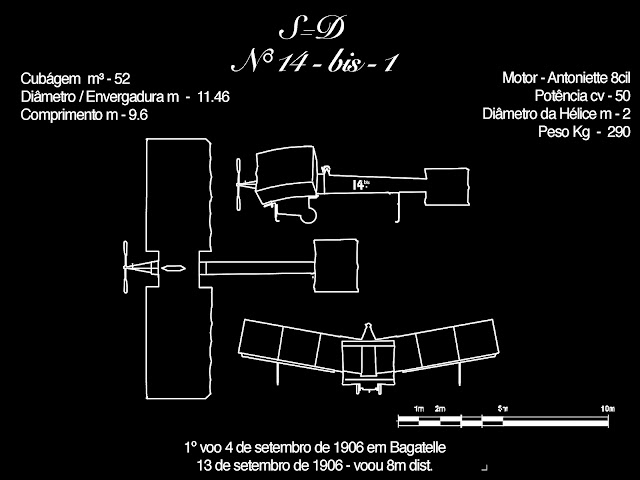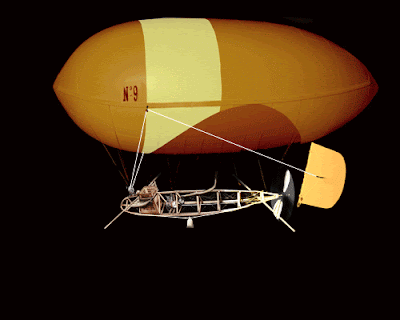leia esta matéria em Português
Undoubtedly the Dirigible Santos=Dumont Number
9, also called "La Balladeuse" (the carriage) was the most elegant invention for solo
flight.
Santos=Dumont
conducted his experiments with style. Trends such as dandy, neo Victorian,
steam punk, etc., transformed him in sort of an artist-scientist.
Next, I bring some
French and American publications telling about his achievements when he was flying his
dirigible Number 9 over the streets of Paris.
- New York Herald June
24, 1903
(You will see that in
this text the location of the Santos=Dumont shed is mistakenly located in St.
James, when in fact, the true location was in St. Cloud. I put the article as
it was written, and I suggest that you may ignore the errors).
"M. Santos-Dumont
in his number 9 going for breakfast on the Champs-Elysees.
M. Santos-Dumont Goes
in His Number 9 to breakfgast in the Champs-Elysees.
Makes early morning trip from the balloon shed at Neuilly to his
residence.
A SATISFACTORY EXPERIMENT
Has constructed landing-stage
on his balcony for use on future occasions
M. Santos-Dumont
yesterday made an earlier appearing trip in the Santos-Dumont No.9 from his
balloon shell at St. James to his residence, No 114 Avenue Chaps-Elysees, where
he took breakfast with some friends and then returned to the “starting-point”.
This remarkable
ballooning feat formed the subject of a most interesting interview between the
aeronaut and a correspondent of the “Français, who found M. Santos Dumont later
in the day reading quietly at his balcony at the corner of the rue “Washington”
and the avenue des Chaps Elysees. His looking as unconcerned as though he had
just returned from a walk.
He stated that he had
been desirous for some days of taking a trip over the city but he did not care
to take the risk in the small steerable balloon, as it would have been
dangerous to travel above the houses with so small an amount of ballast on
board. In his No. 9 however, he can carry a greater quantity of ballast, so he
decided to make the trip in that balloon.
The weather on Monday
had much improved and there was every appearance of the might being a fine one,
so M. Santos-Dumont gave orders to his workman to hold themselves in readiness
for yesterday morning of about seven or eight o’clock.
The night of Monday
turned really beautiful and as chance pulled it, M. Santos-Dumont could not
sleep. No he decided to get up much earlier than he had intended. It was three
o’clock when he rose, and he immediately put of for the balloon shed, which he
reached at four o’clock exactly.
The wind was blowing in
the contrary direction to that which he desired to travel and it was no light
that he thought, it would not impede the program of the No. 9 to a very great
extent.
His workman were all
sound asleep when he arrived at the shed, as they were not expecting him until
three hours later at the --- M.
Santos-Dumont awoke them, however and they set to work at once on the
preparation, which were completed about six o’clock.
All ready.
The automobiles in
which the workmen were to follow the balloon were then got out, and all was
ready for the start.
M. Santos-Dumont
mounted the framework, and the No. 9 sailed into the air, the wind was still
very light, and even showed signs of slackening.
There was a slight
mist in the air, which was considered a good augury of continuance of fine
weather.
The balloon was at
first maneuvered in all directions to test the steering apparatus and then a
turn was taken towards the Avenue du Bois du Boulogne. M. Santos-Dumont says he
had never seen that avenue in such a deserted condition. Not a person was in
sight and not another vehicle beyond the two automobiles containing the
workman.
The temptation to
continue the trip was very great, and M. Santos- Dumont decided to carry it
out. He arrived without any difficult at the Arc de Triomphe, his guide-rope
trailing along the road, as there was no danger of impeding the traffic under
the prevailing conditions.
Round the Arc.
He steered his balloon
right round the great monumental arch in order still further to test his
steering gear, and the begun his journey along the avenue du Champs Elysees,
There almost the same solitude prevailed as in the avenue du Bois although it
was then nearly seven o’clock.
Click on the image above to see how Santos=Dumont used the steering apparatus to turn the Dirigible No 9 to the left or to the right
As he approached his
residence the streets began to present a more lively appearance. Workmen were
going to start their day’s labor, newspaper porters were going to from house to
house, and the city watermen had sprinkling the roads.
On arriving the
opposite door of his house he recognized some friends, whom he hailed. Then the
balloon began to descend and finally aligned exactly before the entrance. The
workmen who had followed assisting with the guide-rope.
His Landing Stage.
M. Santos-Dumont
explained that later on he would have no need or the services of his workers to
assist him in landing at his residence, as he had landing-stage constructed in
connection with his balcony and when he arrived home in his balloon it would
only be necessary to call up servants. He did not do that yesterday morning as
he had not given them notice of his intention.
This landing stage is
an excellent arrangement made according to M. Santos-Dumont from the plans
given in a book describing the future of aeronautics written by an English
author. In this volume a complete system of ballooning is described, which
emprises full details of the proper way to land at houses when one is able to
steer a balloon.
Once in his house, M.
Santos-Dumont took a light repast with the friends he had hailed in the street,
after which he left on his way back to the balloon shed.
Click on the image above to see how Santos=Dumont steer his dirigible Number 9 up and down
At the beginning of
the return journey, the wind having meanwhile increased in force, the balloon
was directed along the avenue by means of the guide-rope. M. Santos-Dumont
himself did not wish to take advantage of this precaution, but his assistants
pointed out the danger, and he gave way to their advice.
Once in the Bois,
however, the guide-rope was let go, and M. Santos-Dumont resumed his journey,
relying on the steering apparatus, and in good time and after a most successful
experiment, he arrived at his balloon-shed at St. James.
M. Santos-Dumont is so
well satisfied with his experience that he intends shortly to make further
trials of the same kind.
 |
| Dirigible Number 9 in celebration of July 14, 1903 Long Champ |
 |
| Airship Number 9 in celebration of July 14, 1903 Long Champ |
July 23, 1903 - Santos=Dumont went up with a huge and powerful lighthouse manufactured in the workshops of his friend Louis Bleriot, and with the lighthouse installed in the bow of his number nine, he made the first night flight of an airship.
“I had just sat on the terrace of a café on the Avenue du Bois de Boulogne, and I was enjoying a cold orangeade. Suddenly, I was startled to see an aircraft descend right in front of me. The guide rope wrapped around the legs of my chair. The aircraft stopped just above my knees, and Santos-Dumont disembarked. True crowds advanced and enthusiastically acclaimed the great Brazilian aviator; they admire courage and sportsmanship.

Santos=Dumont kindly apologized for having scared me; after which he ordered an apéritif, sipped it leisurely, climbed back into the airship, and was gone, gliding through space. I am happy to have seen the bird-man with my own eyes.
The next day, I went to the Bois de Boulogne. Just as my car was about to cross the Porte Dauphine, the bird-man landed on the pavement. The police rushed forward, bringing to a halt all passers-by on foot, on horseback and in all types of vehicles. The trotting horses neighed, the engines roared in the cars that were being abruptly braked, jolting their occupants. Nannies who took children out for a walk in the fresh air were nervous. What was going on? Was there any conflict? No. It was Santos-Dumont on another of his aerial tours.
It's night. I go walking under the trees. Suddenly I trip over a rope. This one looks absolutely nothing like Rapunzel's braid. I hear the rustling of leaves above me, and an angry voice shouts:
 |
| Night flight of Santos=Dumont through the streets of Paris |
'I can not see anything! I'm going to break my head!' I lift my nose in fright, and see a dark monster whose eye glows with acetylene. It's not a gigantic owl; it's Santos-Dumont's enchanted vehicle!
It's dawn, and I'm on my way home. Supper went on for too long, and we had the unreasonable idea of trying new drinks of American origin. My legs feel like Jell-O and my head isn't quite right. The Champs-Elysees is deserted, in the twilight of dawn.

Suddenly someone yells something at me. This is obviously an illusion, as there is no one around at that time. But not! I need to believe my ears! It is really to me that a mysterious voice cries out: ‘Move to the right! My guide rope is going to hit him. It's him again! Always him! Him above all! He descends meekly onto his balcony, and his servants bring him breakfast.”
What End Did N9 Come to?
Santos=Dumont would never leave his best airship in hands he didn't trust, and in fact the man who bought La Baladeuse Nº9 and Santos=Dumont Nº 8, was a great man, as well as the first man to pilot an airship in America, a true Aemrcian friend, Edward C Boyce.
It is important to say here that perhaps the Number 8 airship, purchased by Boyce, is the modified Number 6, just as No. 6 came from modifications to No. 5 after the accident of 8 August. The criteria for numbering Dumont's airships were never clear.
Boyce was undoubtedly a multifaceted figure at the beginning of the 20th century, who dedicated himself to the emerging aviation of the time, becoming one of the pioneering creators of the Aero Club of America.
This is where the intriguing part comes – there is no date of his birth, death, little is known about his contributions to the Aeroclube, not even a good photo of him.
 |
| Photo of Boyce's office 302, Broadway, NY - 1904 Park Catalog |
One of the most intriguing claims about him is that he was the first man to pilot an airship in America, as reported in THE EVENING TIMES article of October 1, 1902.
 |
| Article in THE EVENING TIMES of October 1, 1902.
|
“The dispute was between the Santos=Dumont airship No. 8 (some Dumontologists believe it may have been No. 6), the large airship that had been at Brighton Beach all summer, and the Pegasus, the rival aviator's airship, which was in a stable in Manhattan.”
Both Dumont and Boyce, for reasons linked to inflamed egos and distorted historical narratives, never received recognition for their enormous achievements.



















































